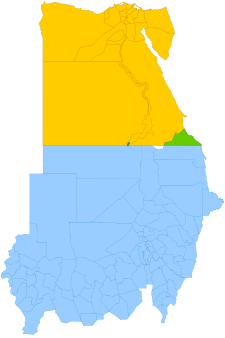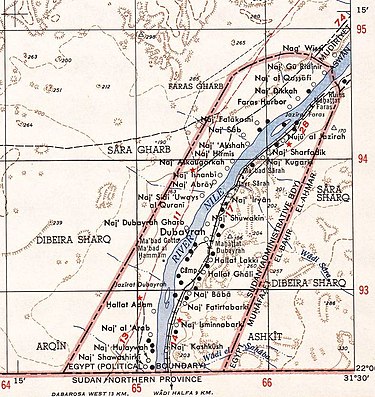
The geography of Egypt relates to two regions: North Africa and West Asia.

Sudan is located in Northeast Africa. It is bordered by Egypt to the north, the Red Sea to the northeast, Eritrea and Ethiopia to the east, South Sudan to the south, the Central African Republic to the southwest, Chad to the west and Libya to the northwest. Sudan is the third largest country in Africa, after Algeria and the Democratic Republic of the Congo. It was the largest country on the continent until South Sudan split off from it in 2011.

Red Sea Governorate is one of the 27 governorates (States) of Egypt. Located between the Nile and the Red Sea in the southeast of the country, its southern border forms part of Egypt's border with Sudan. Its capital and largest city is Hurghada.
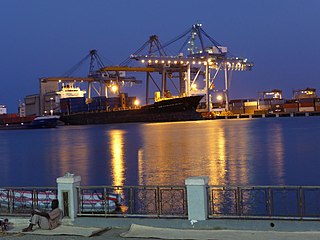
Red Sea State is one of the 18 states of Sudan. It has an area of 212,800 km2 and an estimated population of 1,482,053 in 2018. Port Sudan is the capital of the state. Sudan claims, but does not control, the Halaib Triangle, a region disputed between Sudan and Egypt. The original inhabitants of the state are the Beja people who constitute more than 65% of the total population, with lower wealth and power in the region.

Wādī Ḥalfā is a city in the Northern state of Sudan on the shores of Lake Nubia near the border with Egypt. It is the terminus of a rail line from Khartoum and the point where goods are transferred from rail to ferries going down the lake. As of 2007, the city had a population of 15,725. The city is located amidst numerous ancient Nubian antiquities and was the focus of much archaeological work by teams seeking to save artifacts from the flooding caused by the completion of the Aswan Dam.

The Halaib Triangle is an area of land measuring 20,580 square kilometres (7,950 sq mi) located on the Northeast African coast of the Red Sea. The area, which takes its name from the town of Halaib, is created by the difference in the Egypt–Sudan border between the "political boundary" set in 1899 by the Anglo-Egyptian Condominium, which runs along the 22nd parallel north, and the "administrative boundary" set by the British in 1902, which gave administrative responsibility for an area of land north of the line to Sudan, which was an Anglo-Egyptian client at the time. With the independence of Sudan in 1956, both Egypt and Sudan claimed sovereignty over the area. The area has been considered to be a part of the Sudan's Red Sea State, and was included in local elections until the late 1980s. In 1994, the Egyptian military moved to take control of the area as a part of Red Sea Governorate, and Egypt has been actively investing in it since then. Egypt has been recently categorical in rejecting international arbitration or even political negotiations regarding the area.

The Cataracts of the Nile are shallow lengths of the Nile river, between Khartoum and Aswan, where the surface of the water is broken by many small boulders and stones jutting out of the river bed, as well as many rocky islets. In some places, these stretches are punctuated by whitewater, while at others the water flow is smoother but still shallow.

Faras was a major city in Lower Nubia. The site of the city, on the border between modern Egypt and Sudan at Wadi Halfa Salient, was flooded by Lake Nasser in the 1960s and is now permanently underwater. Before this flooding, extensive archaeological work was conducted by a Polish archaeological team led by professor Kazimierz Michałowski.
The New Halfa Project in Sudan is a 164,000 feddan site constructed in 1964 to house 50,000 Nubians displaced from Wadi Halfa, a town situated on the Nile near the border with Egypt, which was flooded when Lake Nasser formed behind the Aswan Dam. The site draws its water from the Atbara River, where the Khashm el Girba Dam provides a reliable source for the irrigation project intended to convert the nomads of the area to farmers of cotton and sugar.

The Ilemi Triangle, sometimes called only Ilemi, is a disputed area in East Africa, claimed by both Kenya and South Sudan. Arbitrarily defined, it measures about 11,000 square kilometres (4,200 sq mi). The term "Ilemi" may more accurately be transcribed as "Elemi" in the Didinga language, signifying acceptance. This suggest that, in Didinga history, the region became favorable when they arrived, evidenced by the thriving health of the cattle that accepted the local vegetation, indicating a symbiotic relationship between the cattle's well-being and the area. The territory is claimed by South Sudan and Kenya. The territory also borders Ethiopia and, despite use and trespass into the triangle by border tribes from within Ethiopia, the Ethiopian government has not made any official claim on the area, instead agreeing that the land was Sudanese territory in the 1902, 1907, and 1972 treaties.
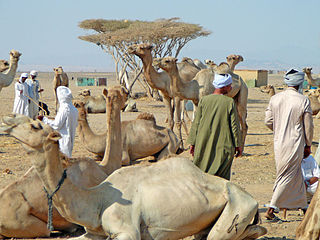
Shalateen is the biggest town in the Halaib Triangle, a disputed territory claimed by both Egypt and Sudan. It is located 520 km (320 mi) south of Hurghada and is controlled as the administrative center (markaz) of all Egyptian territory up to the border between Egypt and Sudan, including the villages of:

Railway stations in Sudan include:

Bir Tawil is a 2,060 km2 (795.4 sq mi) area of land along the border between Egypt and Sudan, which is uninhabited and claimed by neither country. When spoken of in association with the neighbouring Halaib Triangle, it is sometimes referred to as the Bir Tawil Triangle, despite the area's quadrilateral shape; the two regions border at a quadripoint.

The 22nd parallel north is a circle of latitude that is 22 degrees north of the Earth's equatorial plane. It crosses Africa, Asia, the Indian Ocean, the Pacific Ocean, North America, the Caribbean, and the Atlantic Ocean.

Sudan has 4,725 kilometers of narrow-gauge, single-track railways. The main line runs from Wadi Halfa on the Egyptian border to Khartoum and southwest to El-Obeid via Sennar and Kosti, with extensions to Nyala in Southern Darfur and Wau in Western Bahr al Ghazal, South Sudan. Other lines connect Atbara and Sennar with Port Sudan, and Sennar with Ad-Damazin. A 1,400-kilometer line serves the Al Jazirah cotton-growing region. There are plans to rehabilitate rail transport to reverse decades of neglect and declining efficiency. Service on some lines may be interrupted during the rainy season.

Abu Simbel is a village in the Egyptian part of Nubia, about 240 km (150 mi) southwest of Aswan and near the border with Sudan. As of 2012, it has about 2600 inhabitants. It is best known as the site of the Abu Simbel temples, which were built by King Ramses II.

The Sudans is a region in Northeast Africa comprising the sovereign countries of Sudan and South Sudan. Until 2011, the region was united under a state known as the Republic of the Sudan.
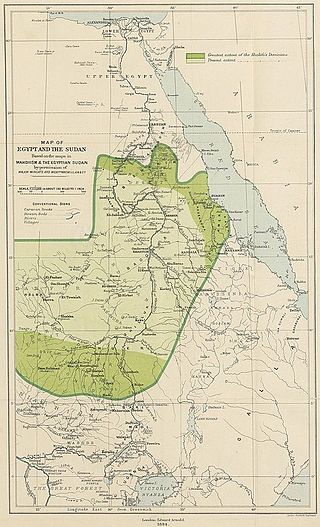
The Anglo-Egyptian conquest of Sudan in 1896–1899 was a reconquest of territory lost by the Khedives of Egypt in 1884–1885 during the Mahdist War. The British had failed to organise an orderly withdrawal of the Egyptian Army from Sudan, and the defeat at Khartoum left only Suakin and Equatoria under Egyptian control after 1885. The conquest of 1896–1899 defeated and destroyed the Mahdist State and re-established Anglo-Egyptian rule, which remained until Sudan became independent in 1956.
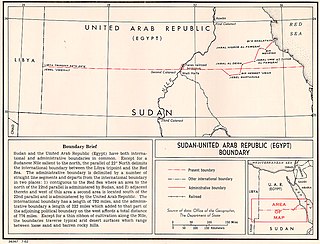
The Egypt–Sudan border is 1,276 km in length and runs from the tripoint with Libya in the west to the Red Sea in the east. The eastern section of the border is subject to a territorial dispute between the two states.
This is a list of the extreme points of Sudan, the points that are farther north, south, east or west than any other location.
